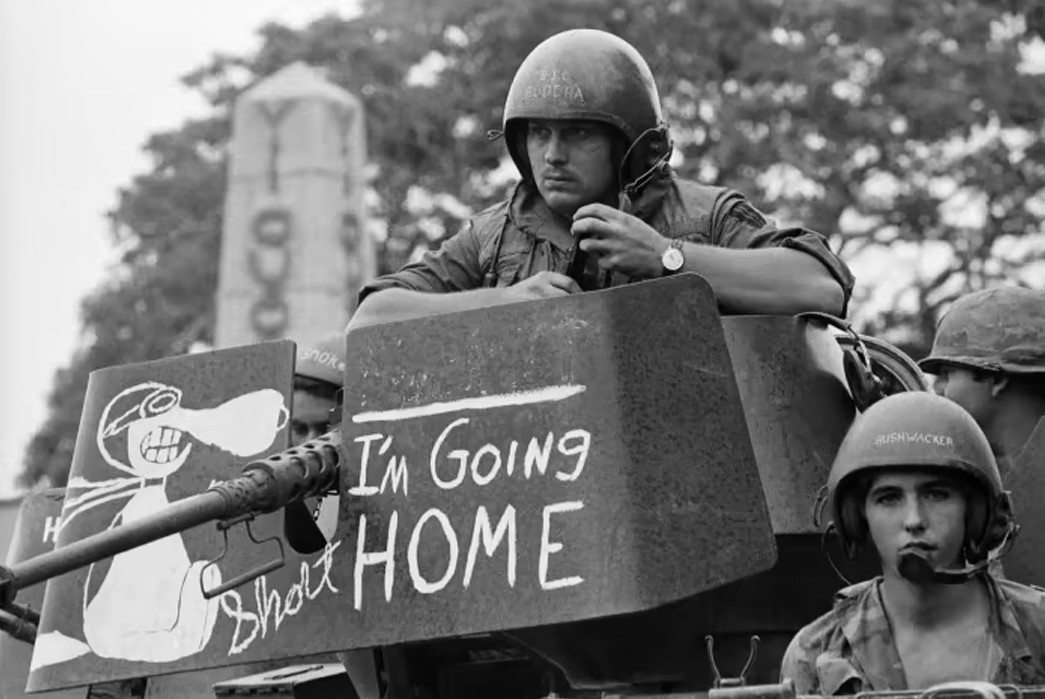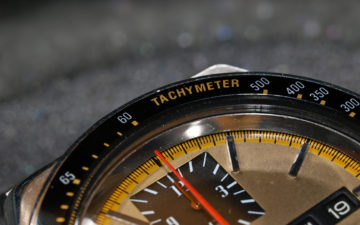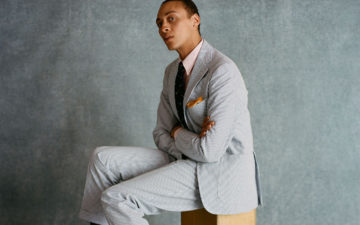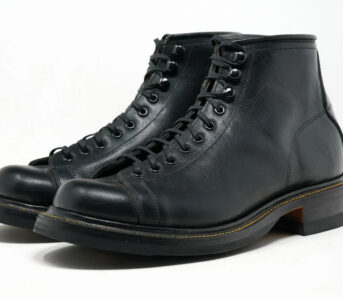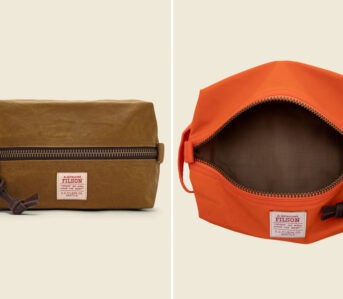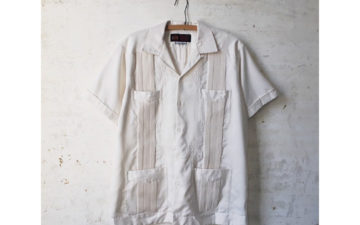Over 50 years and nearly 18,000 comic strips, the story of Peanuts introduced us to some of the world’s most recognizable and loved cartoon characters, in particular, troubled boy Charlie Brown and his daydreaming beagle Snoopy. Since its inception in 1950, Peanuts has also had a profound effect on both popular and counter culture with Schulz‘s characters becoming part and going against the status quo.
In Part 1 of this two-part series, we explored the history of Schulz and his comic strip, and explored why it remains so admired 70 years later. In this second part, we’ll dive into the impact that Peanuts has had across the cultural spectrum, including the visual imagery of the Vietnam War and the Space Race.
Happiness Is…
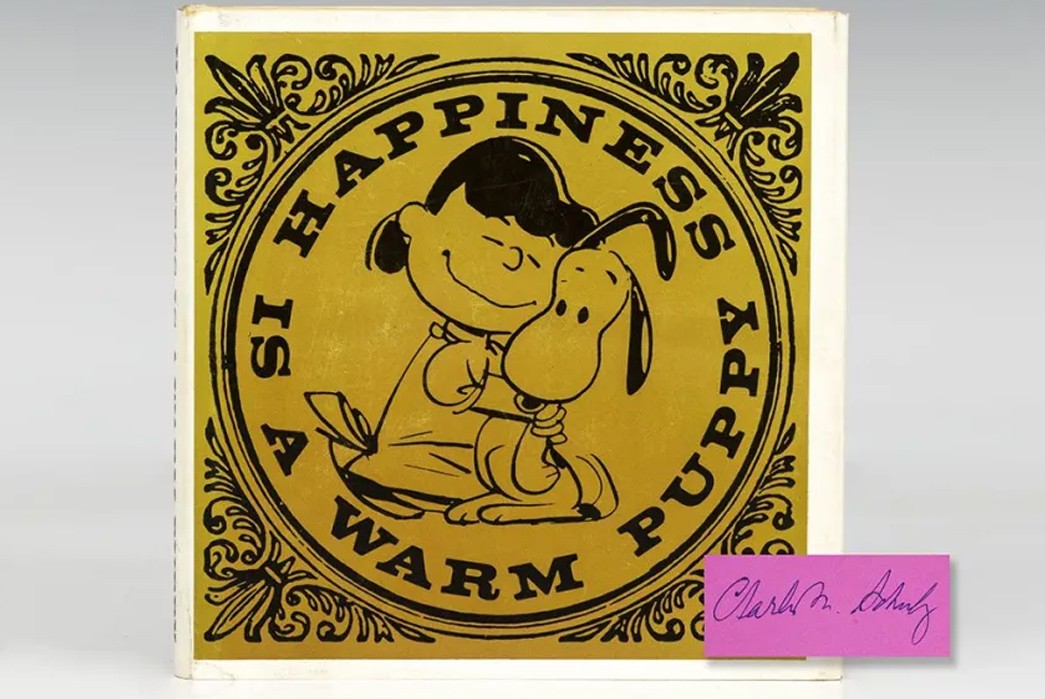
A signed first edition of Happiness Is A Warm Puppy, the first Peanuts book via Raptis Rare Books
Peanuts has been a huge marketing phenomenon. Schulz was quick to act on the comic’s early popularity and the first Charlie Brown and Snoopy toys were released in 1958. By the time of his death at the turn of the century, around 20,000 new Peanuts products were being produced every year—so it’s no surprise that the comic has infiltrated popular culture.
The popularity of Peanuts merch really kickstarted in 1962, 12 years after Schulz’s first comic strip hit US newspapers. Schulz’s syndicate, United Features, was constantly approached by companies hoping to license Charlie Brown, Snoopy, and the other characters but struggled to find the right fit. Then in ’62, Connie Boucher, a San Franciscan window designer, came to Schulz with a simple idea: Peanuts datebook calendars. Schulz loved Boucher and her ideas so the same year they released the first licensed Peanuts book Happiness Is… a Warm Puppy. It spent 45 weeks, the best part of a year, on The New York Times bestseller list. Boucher went on to found Determined Productions Inc.
Determined Productions was responsible for a huge range of Peanuts wares but was best known, apart from their books, for releasing the original Peanuts sweatshirts in 1965. The first Determined Productions sweatshirts featured a member of The Gang and their name on the front and one of their trademark slogans in the same poppy fonts as the books they produced with Schulz. They were printed on some amazing raglan-sleeved sweatshirts in colors they named Grassy Green, Peacock Blue and Sunshine Yellow, Shocking Pink, Perfect Peach, and Byzantine Blue. These sweatshirts are, to this day, some of the most sought-after vintage sweatshirts out there.
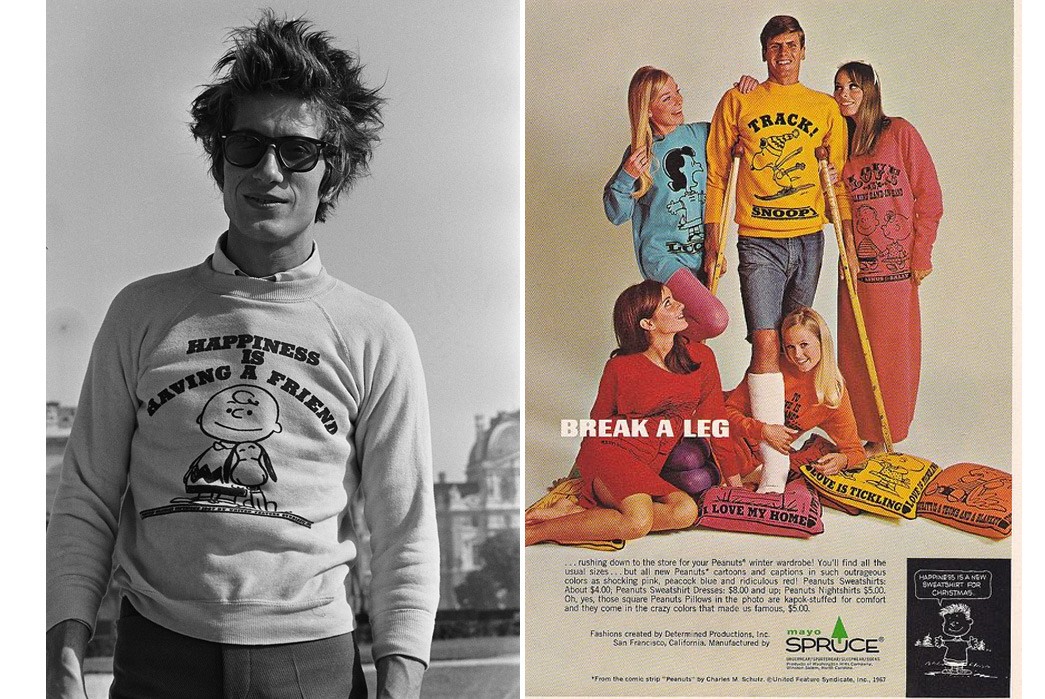
The second wave of Determined Production’s designs from 1968 via TSPTR and a 1967 Peanuts winter wardrobe ad via Pinterest
Things changed again in 1974. Schulz resolved an ongoing conflict with United Features which gave him complete creative control over the licensing of Peanuts and the characters he’d brought to life. It could be said that this was what has kept Peanuts alive to this day. As well as numerous licensing deals for clothing, toys, kitchenware, and just about everything you can think of, Charlie Brown, Snoopy, and their friends have been used to advertise 7-Eleven, All Nippon Airways, Coca-Cola, Kraft Mac & Cheese, Random House Software, Travelodge, and an ever-expanding list of other companies across the world. To house some of the extensive merchandise and a selection of Schulz’s original work, his wife, Jean, cartoon historian, Mark Cohen, and his friend and attorney, Edwin Anderson, opened the Charles M. Schulz Museum and Research Center in Santa Rosa, California, in 2002.
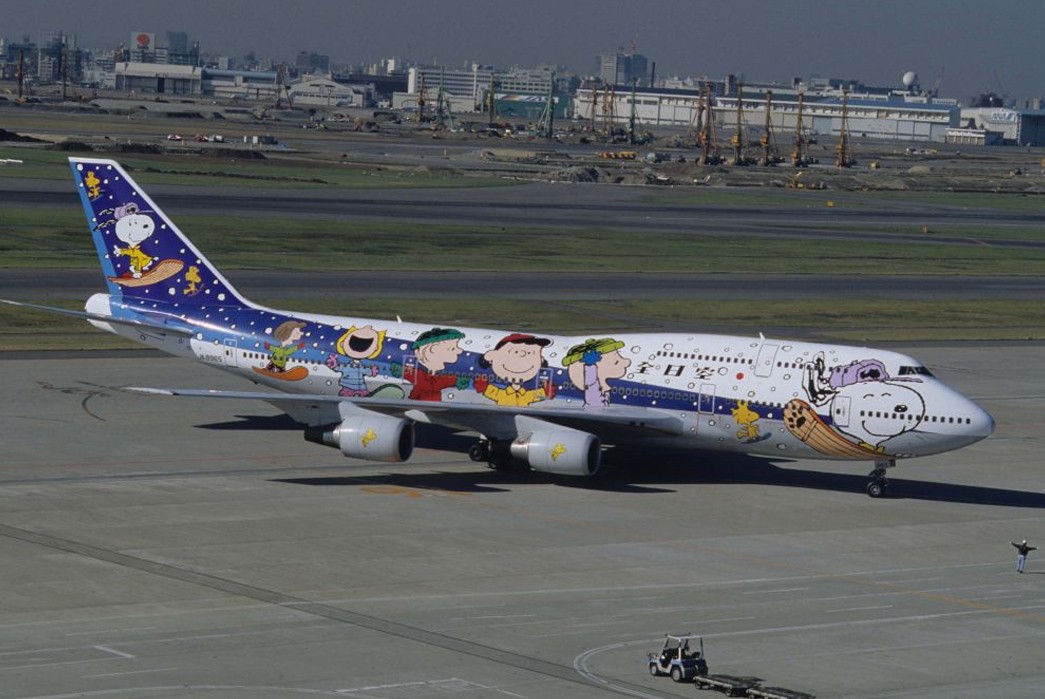
A wintery Peanuts scene on an All Nippon Airways Boeing 747, 1998 via Flight Aware
A lot also has to be said for Peanuts’, particularly Snoopy and Woodstock’s, resonance with Japan. Japanese taste and Kawaii, the culture of cuteness, have made Schulz’s comics and characters a booming success in the country. Their popularity combined with Schulz’s generous licensing agreements has led to a Snoopy Museum in Tokyo, which opened in 2016, a Snoopy chocolate shop in Kyoto, a Peanuts hotel in Kobe, and several Snoopy cha-yas, traditional teahouses, around Japan.
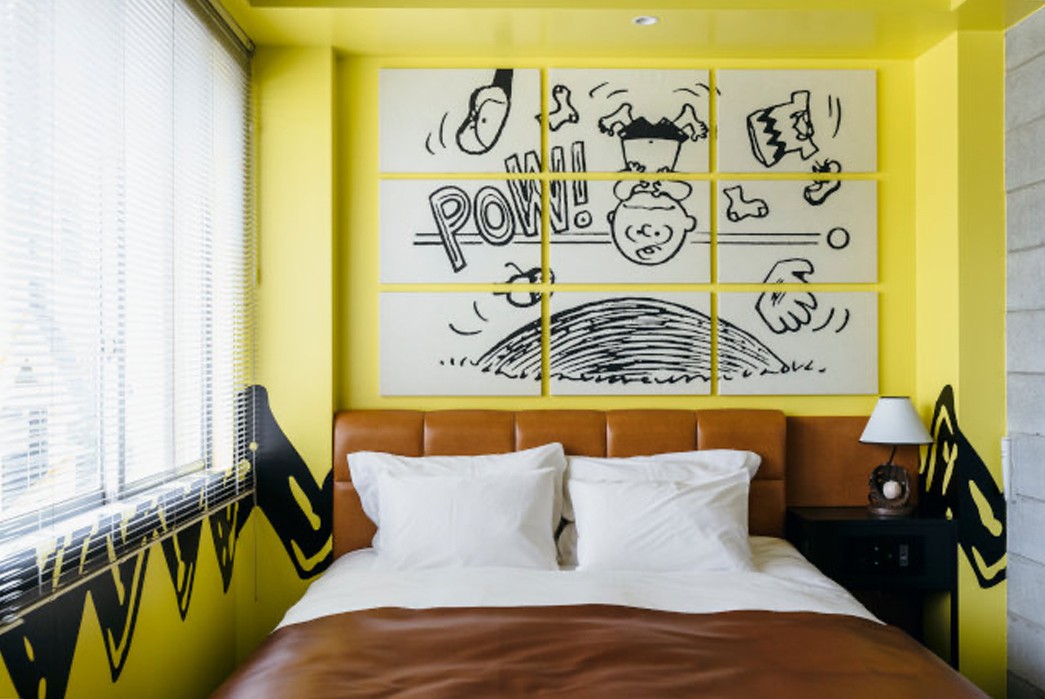
Sleep, eat, and drink Charlie Brown at the Peanuts Hotel in Kobe via Peanuts Hotel
Peanuts products are still popular today and vintage ones are especially cherished and widely collected. It’s easy to see why this is the case: Schulz’s characters are cute and relatable, which we explored deeper in Part 1, and loved by adults and children alike across the world. Though it wasn’t just plush Snoopys and slogans on sweatshirts, Schulz used his comic strips to remark on some of the most tumultuous global events of the time.
Curse This Stupid War!
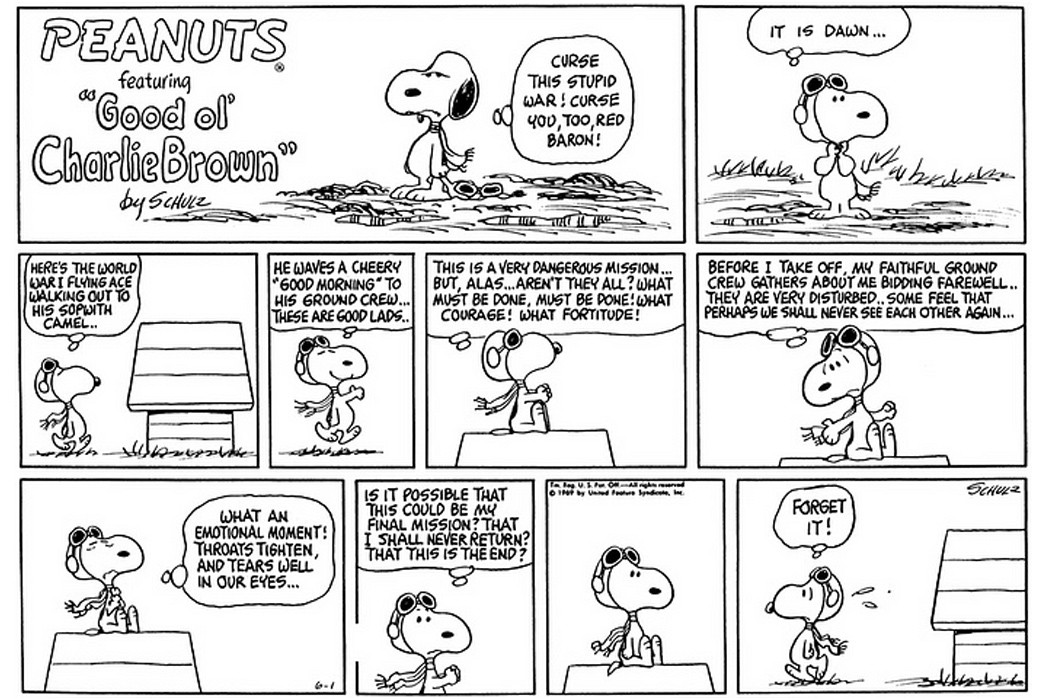
The Flying Ace cursing out the war, June 1 1969 via Go Comics
Charles M. Schulz was drafted into the Second World War in 1943 and spent time in Europe before the end of the war in 1945. Luckily, Schulz never saw combat but this didn’t stop his combat training and time on the front line from having a profound effect on the young artist. 20 years later, America found itself in another conflict in South East Asia, the Vietnam War, and Schulz used Peanuts as a mouthpiece to broadcast his feelings about the war to a national and international audience, and the comic book and its characters became part of the conflict’s visual lexicon.
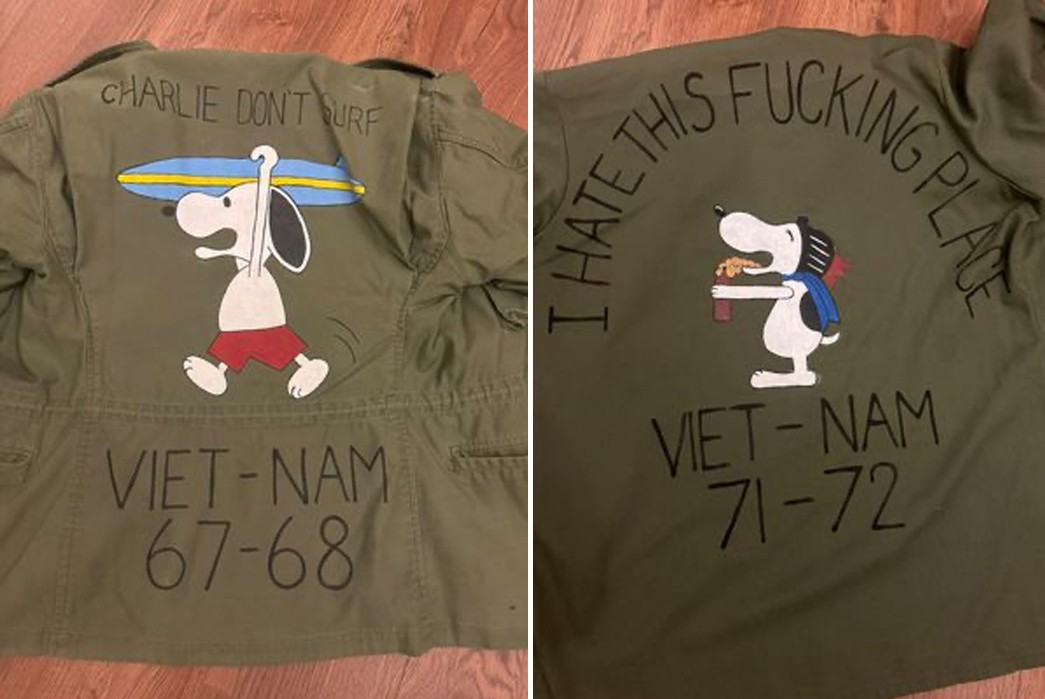
Original hand-painted Vietnam M65 Jacket and Military Shirt via Leon Cerrone
On October 10, 1965, Schulz added a new identity to Snoopy’s ever-growing menagerie: the Flying Ace. Though seemingly just another of Snoopy’s flights of fancies in which a First World War Flying Ace battles his greatest foe, the Red Baron, on a doghouse visualized as a Sopwith Camel, a British fighter bi-plane, Schulz introduced the Flying Ace as an attempt to comment on the developing conflict in South East Asia. Snoopy’s war fantasies in this period as a reflection of America’s growing real-world concern about the war and tackle the bleakness faced by soldiers serving and the abject tragedy of war.
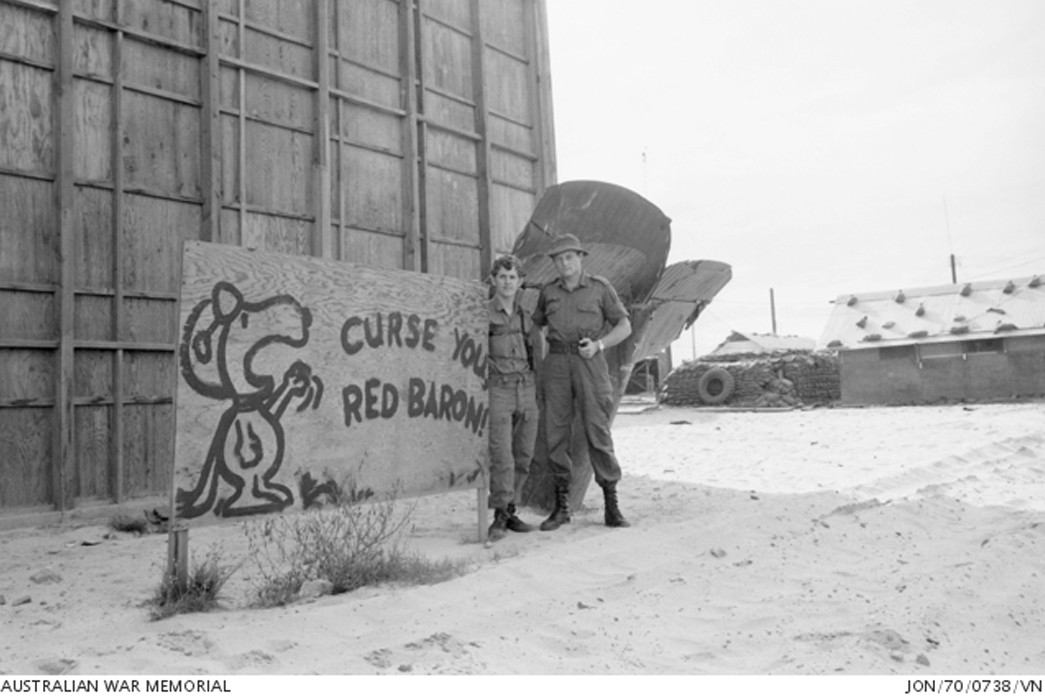
The Flying Ace in South Vietnam, October 1970 via Australian War Memorial
However, as the fighting got worse in Vietnam, Schulz went beyond the Red Baron. One strip saw Charlie Brown and Linus discussing the idea of being drafted and consequently dying in war—a very grave discussion for two small children, but the lived reality of many Americans at the time. Another sees Snoopy’s birthplace, the Daisy Hill Puppy Farm, erupt into riot during a speech about dogs being drafted into the war. Schulz didn’t shy away from putting the anxieties and fears of the American popular about the war into what is essentially a comic strip about a group of kids and a beagle.
One aspect of the war that Americans directly faced at home was the draft. Between 1963 and ’74, 2.2 million American men between the ages of 18 and 26 were drafted to fight in Vietnam. With Peanuts first being published in October 1950, these men would have grown up reading the adventures of Charlie Brown, Snoopy, and The Gang. Given this, and Schulz’s attitudes to the war in his comics, Snoopy and his Flying Ace alter ego became a popular symbol for the men serving in Vietnam—as both a dedication to the conflict and an airing of their frustrations with the war.
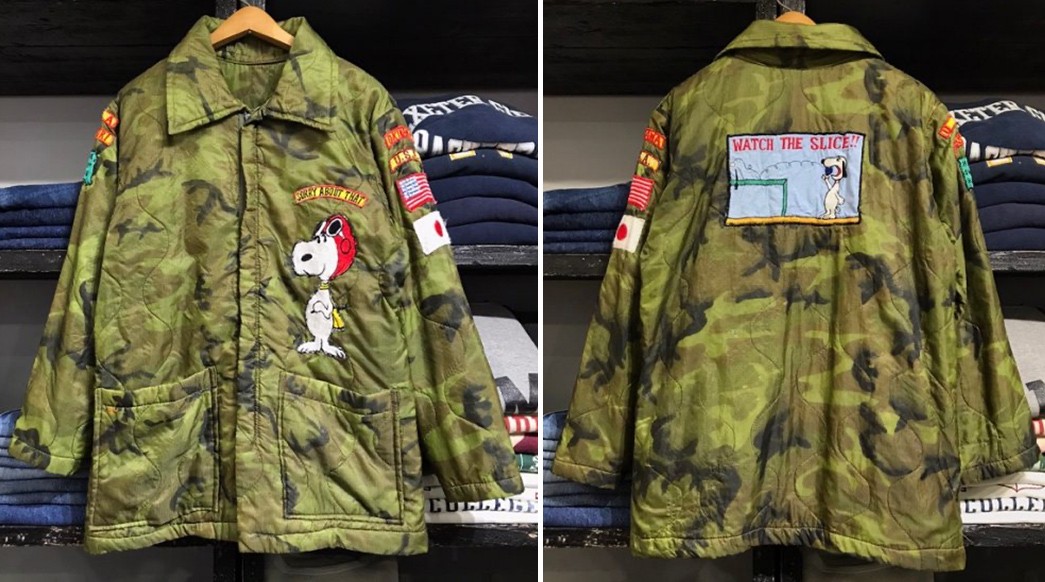
An original Vietnam souvenir jacket with added Snoopy decals via Kuri Kuri Vintage
The war’s unofficial mascot Snoopy appeared on patches, planes, guns, banners, uniforms, and even Zippo lighters. It was in the years of the war in Vietnam that Snoopy became more than just a playful beagle, he became a de facto mouthpiece for the anti-war movement at home and an icon of the War in Southeast Asia.
The First Beagle On The Moon
It wasn’t just the Vietnam War that brought Snoopy to the nation’s attention during these decades. Schulz was a great supporter of the Space Race and NASA’s space program, which culminated in Apollo 11 landing on the moon in July 1969. Humans were, of course, beaten to the moon by beagles—Snoopy landed on the moon in Peanuts four months before, on March 14, 1969, after starting his career at NASA (via Schulz) the previous decade.

Snoopy (and not the neighbor’s cat) on the moon, March 14, 1969, via Go Comics
Cartoons aside, Snoopy and his pal Charlie Brown were actually launched into space. On May 18 1969 the dress rehearsal for the moon landing, Apollo 10, was launched including its lunar module called Snoopy and command module called Charlie Brown. Snoopy passed within 50,000 feet (around 9 miles) of the moon’s surface as it scoped out the location where its successor would land—something that its namesake would have been proud of. The crew of Apollo 10 also took artwork of Charlie Brown and Snoopy that helped to calibrate cameras and record the first ever color TV images broadcast from space. Schulz himself, despite a huge amount of success, said this was the proudest moment of his career.
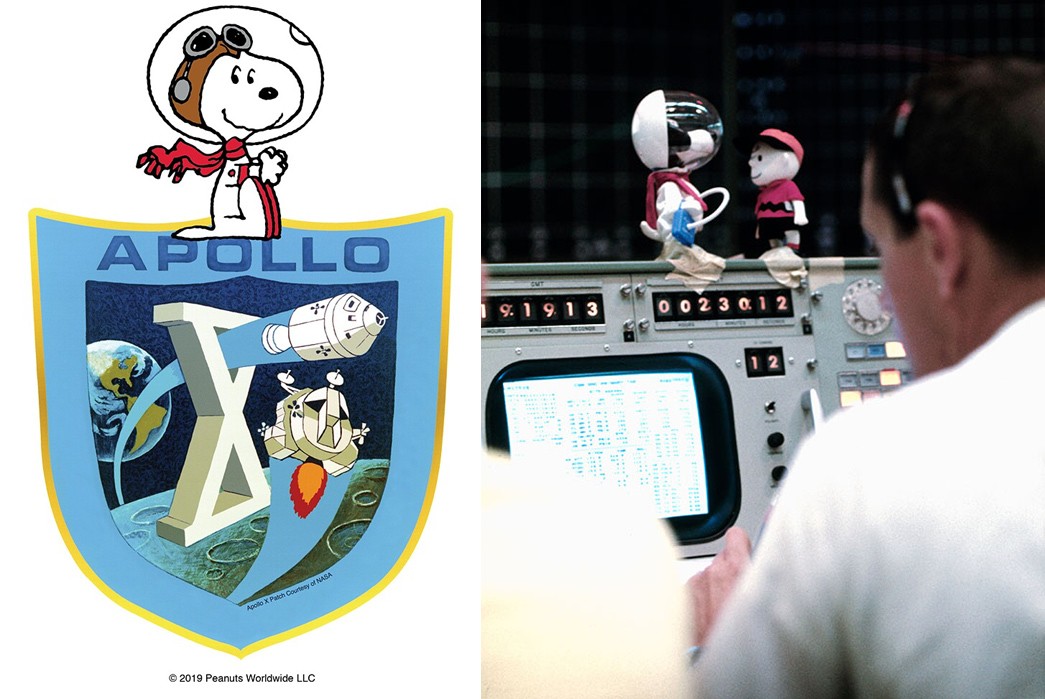
The Apollo 10 Mission Patch via PBS SoCal and Astronaut Snoopy and Charlie Brown figurines helping out at the Apollo 10 Control Centre via Kennedy Space Center
Snoopy’s relationship with NASA didn’t end there. The previous year he became NASA’s official safety mascot and the Silver Snoopy Award was founded. The prize is given for “outstanding achievements related to human flight safety or mission success” and has been awarded to over 15,000 people over the last 55 years. Each winner is given a small silver pin, based on an original drawing of Snoopy the Astronaut by Schulz himself—all of which have been flown into space.
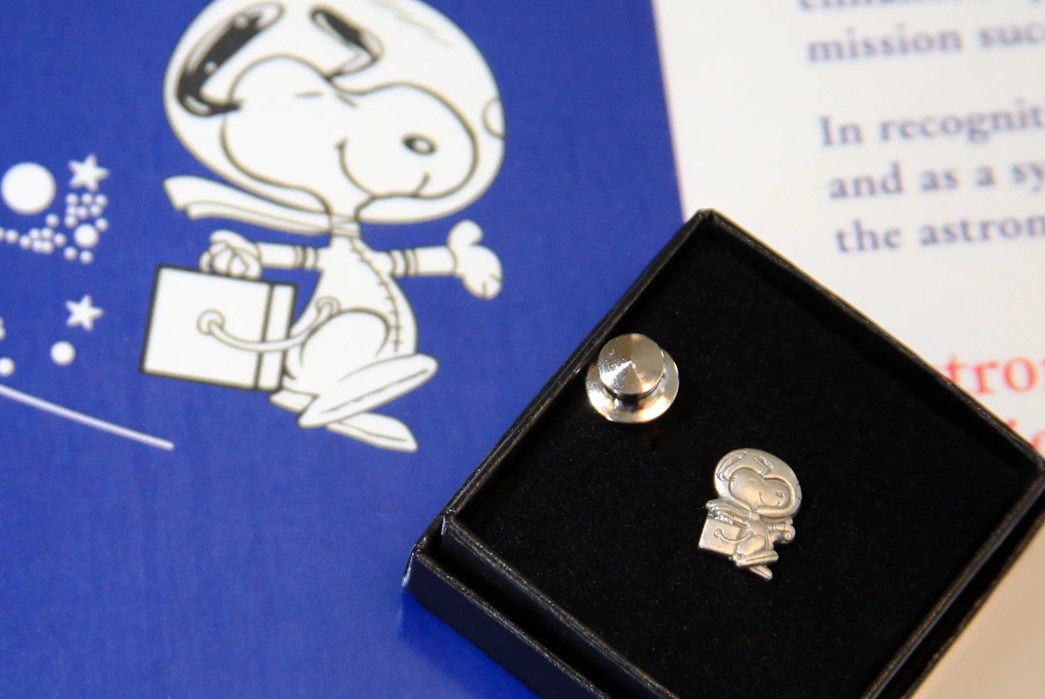
The Silver Snoopy Award pin, certificate, and commendation letter with the date it went to space via NASA
Snoopy returned to space last year, in 2022, on board the Artemis 1—which makes a return to NASA’s lunar exploration.
An American Dream
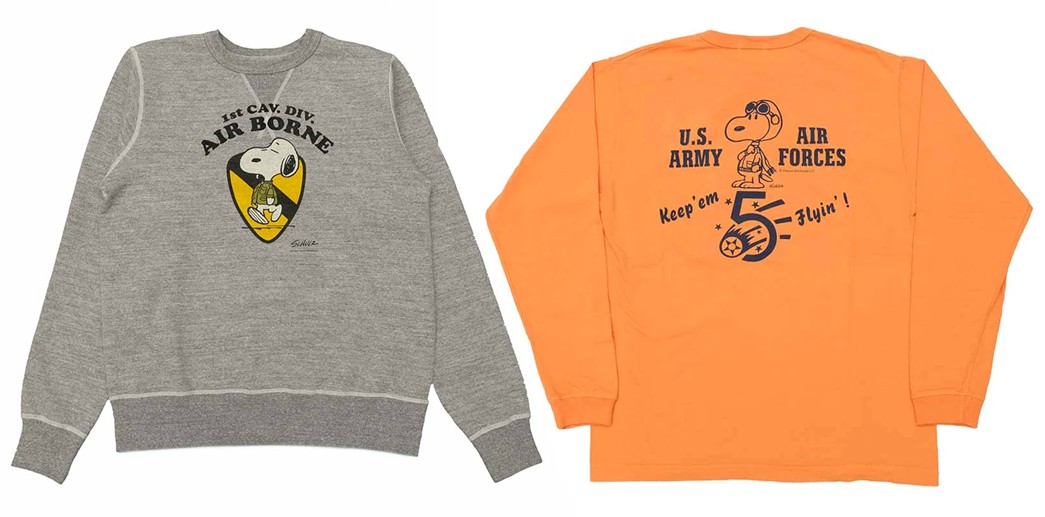
Buzz Rickson’s x Peanuts Air Borne Set-In Crew Sweatshirt and Keep ’em Flying L/S T-shirt via Hinoya
Determined Productions, the Vietnam War, and the Space Race raised Schulz’s characters — especially Snoopy — to new heights. They became national icons and played a hugely important part in the visual imagery of the 1960s and ’70s. We saw them become ingrained in the fabric of the country—quite literally in some cases.
It’s this rich heritage of midcentury Americana that makes Peanuts part of the heritage scene that Heddels celebrates and why we wanted to explore its legacy. It’s also this legacy, and the counter-cultural aspects of Schulz’s work, that sees both anything vintage with a member of The Gang on it being super collectible and reproduction brands using Schulz’s characters on their clothes—from the embroidered military garb to Sunshine Yellow sweatshirts.
Snoopy, Charlie Brown, and their gang of misfit friends are the perfect representation of 20th-century America—and that needs remembering.
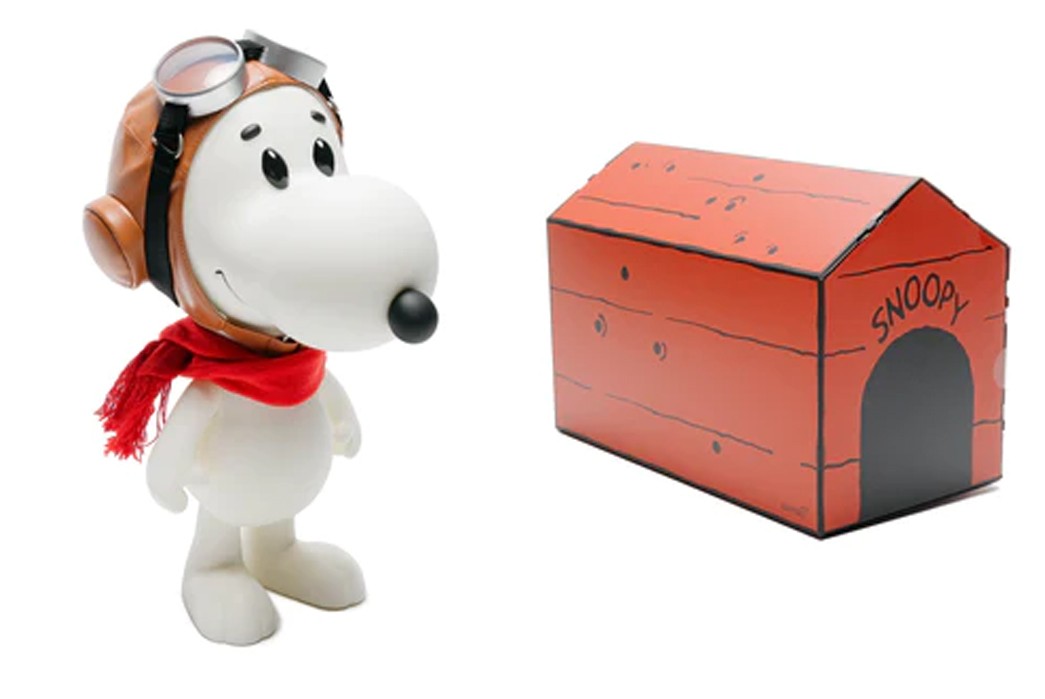
Super7 SuperSize vinyl Flying Ace Snoopy and his doghouse box via Lost & Found
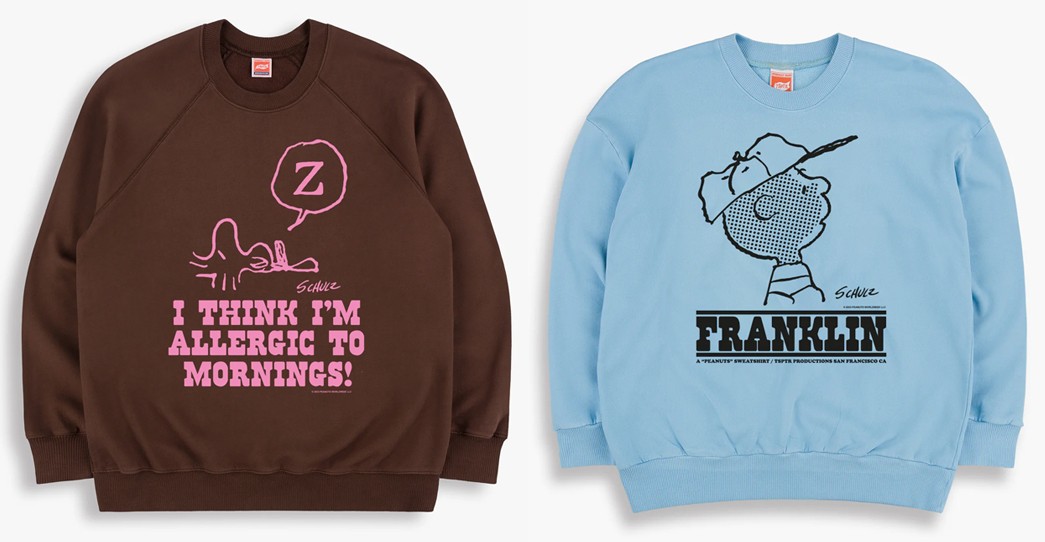
Mornings and Franklin sweatshirts based on the original 1960s Determined Productions designs via TSPTR
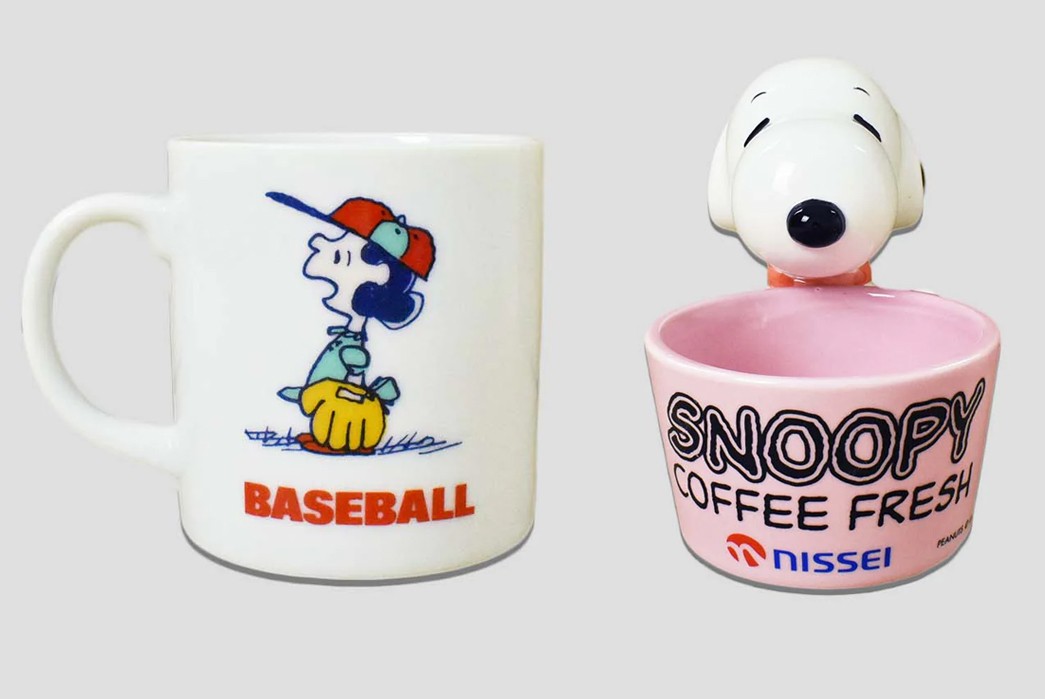
Lucy Van Pelt Baseball Mug and Snoopy x Nissei Sugar Bowl via Isami Lifestore

